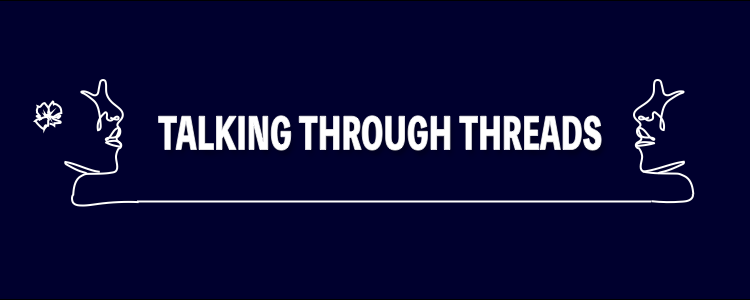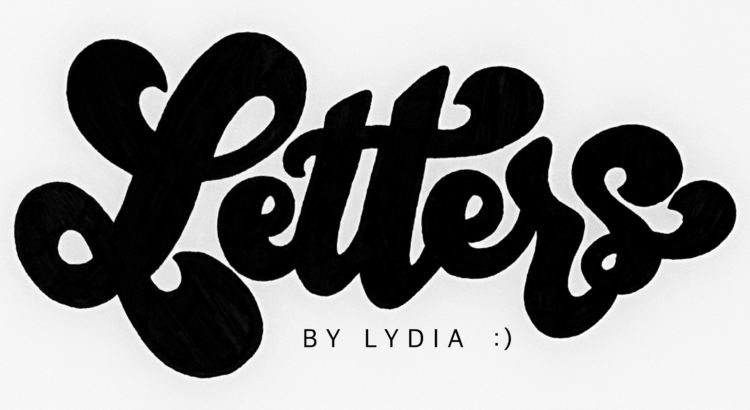Thread of connections
Weaving your thoughts for display,
What are you saying?



Thread of connections
Weaving your thoughts for display,
What are you saying?


Welcome back to another post! Today is all about faux calligraphy, so let’s start by explaining what that even is.
Faux calligraphy got its name by, as you might have guessed, being a sort of “fake” form of calligraphy. Where traditional calligraphy uses a brush pen to get those thin upstrokes and thin downstrokes, faux calligraphy allows you to get the same technique with a regular old pen (or, really, any sort of pencil, marker, etc that creates a standard line).

So how does this work? It’s actually pretty simple, which is why a lot of people, especially beginners, prefer it over traditional calligraphy. A lot of beginners also use it as a gateway into traditional calligraphy, because it uses the same principles without requiring the technique involved in using a brush pen.
To start, you can just write whatever word/letter/phrase you have in mind. This can be in cursive, or in print, whatever you prefer! The next step is the key: you need to identify all the downstrokes. In the example below, I showed where the downstrokes are on the cursive letter “a”, but if you want a more comprehensive guide, I have a few other blog posts about handlettering basics that should help you out! Once you identify where all the downstrokes are, you simply make those lines thicker, whether by drawing an outline and filling it in like I did, or by just adding a few extra lines around it.


Once you’ve got the basics down, this another style where there are a lot of fun variations to play around with. I included some of my favorites below, to show that you can do this with cursive or print, vary the thickness of the downstrokes, bring in color, etc. With the “lazy” and “hard” styles, the lazy one is just what you’ve been doing already (it isn’t lazy, it’s just easier than the hard version). The “hard” version is where you kind of map the downstrokes out in your mind ahead of time so that the lines don’t intersect and downstrokes remain solid white. This takes some practice to get the spacing right, which is why I called it the hard version, but it’s definitely not impossible and can be really fun to practice!

I hope you enjoy trying out a new style, or at least learning about it, and for all the umich students out there, have a great spring break!

Welcome back to Letters by Lydia! Hopefully everyone was able to stay safe and warm in the snow, or maybe even go out and build a snowman 🙂
Today I want to talk about all the times–and trust me, there are many–that lettering ideas and techniques don’t work out. A lot of times in the art community, especially on social media, we only see the work that people are super proud of: work that’s polished, high quality, creative, unique, and so on. Because of this, it can be really easy to fall into the trap of feeling like your work isn’t good enough, or that everyone else is much more talented. That said, I have noticed lately that people on social media seem to be getting a little more vocal about the importance of the process. Bad art is just as important as good art, because it helps you learn and grow as an artist. If your art was perfect all the time, there would be no room for experimentation, doodling, mistakes, and most importantly, fun!
I’m sure none of this is news to most of you, but I wanted to share an example of some lettering I did today that I couldn’t quite figure out. I wanted to try a new lettering style where it looks like letters someone wrote with their finger in the snow, which ended up being much harder than I anticipated.
After consulting an overwhelming number of google images, my first attempt landed me with this:

When I first did this, I wasn’t in love with, but with some distance I can honestly say this might’ve been my best attempt. I chalk it up to beginner’s luck, though, because I could not for the life of me produce this kind of style again. In hindsight, I think the key was only using two colors, because this was the only attempt where I limited my color palette that much.
My next attempt I’m actually super proud of and think looks pretty realistic. The issue? It took forever, so it didn’t feel reasonable to try and do a whole word in this style. My original idea was also to have this as a type of style, not a kind of one-time piece that would be difficult to recreate. In any case, this is what I ended up with here:

After this, I started trying whole words, and played around with using the colors in different ways, different textures, and different thicknesses. I don’t dislike any of these, but I don’t think any of them read quite as I wanted them to–they look like pretty snow-themed pieces, but not necessarily like someone was writing in the snow, unless you’re looking at them with that style in mind.

Of course, in this example of things not working out, I still generally liked the end results, they just weren’t what I had in mind originally. That said, I can’t tell you the number of times I try things that end up looking absolutely terrible, and I can definitely start sharing that stuff too! But I thought it was important to show that there’s also this middle ground where the work you produce is still good, it just doesn’t align with the vision you had, because this also allows for artistic experimentation and learning new styles and techniques.
This is a style I plan to experiment with a bit more and see if it’s something I can refine, but even if it isn’t, I had fun playing around with something new!
I hope you enjoyed reading, and stay safe out there in the snow!
I’m always discovering more about why I love art and what makes a certain work of art stand out to me, and personally that’s one of my favorite parts about enjoying art. Over time I’ve found that I have really unique interests in the underappreciated areas of art, specifically the small details that often go unnoticed by others. I think these details often go unnoticed consciously, but have a huge impact on how we experience art, and that’s why I love to analyze and explore these details in order to better understand why a certain work of art feels the way it does. Recently, I’ve been thinking a lot about art that subverts the viewer’s expectations, whether it be a movie breaking the fourth wall, a game that has an artistic twist, or a song that features variations on a theme that take the listener by surprise. Eventually I would love to explore these concepts in all forms of art, but first I want to start with great examples from two of my favorite games: Journey and Monument Valley 2.
I talked about Journey in a previous post, in which I emphasized it as a game of quality over quantity. It’s an overall spectacular game, featuring a gorgeous color palette, emotional story-line, and a beautiful orchestral soundtrack. I was playing through it again recently when I rediscovered one of my favorite parts, in which the game takes this beautiful breathtaking moment to break its format and reveal itself as the work of art it is. The entire game is from a third person perspective, mostly limited to the back of the protagonist, except in this short and surprising scene where you’re surfing down sand dunes and suddenly enter a tunnel, where the camera pans over to display you in profile with this gorgeous and mystical cityscape laid out under a looming mountain and fiery orange sun. It really is breathtaking when you play the game; it comes out of nowhere, and evokes this feeling of pure serenity and awe that is completely unique to this game. The visual nature is perfectly complemented by a reprieve in the music, featuring a bittersweet cello representing the solitary character. It’s an incredible game as a whole, but I think this moment itself characterizes the entire artistic feeling of the game. Art is an emotional medium, and understanding how that emotion is conveyed is essential to understanding what makes it unique. In Journey, it’s this subversion of expectations and a fleeting moment of calm that forces the player to step back and evaluate how the game conveys emotion.
Another great example of art subverting expectations is Monument Valley 2. I’ve discussed Monument Valley before, specifically how it stands apart as a mobile game and how the soundtrack itself is a great example of thoughtful and well made ambient music. However, Monument Valley 2 does something special that the first doesn’t, and that’s including a variation of the theme, essentially breaking its own rules and forcing the viewer to rethink their understanding of the game. The entire game relies on ‘impossible geometry’, level design that is impossible in the real world, but stunning and satisfying in the minimalist world of Monument Valley. It’s 3D and geometric as a result, using an isometric style to make the impossible geometry possible, which in turn defines it’s artistic style and sets the expectations on how the game is played. However, in one sub-level of the game, seemingly out of nowhere, the game breaks its own format and the result is another breathtaking moment (that may sound dramatic, but I’m not exaggerating when I say that these details make me pause with appreciation and respect). Instead of following the expected 3D style, the level is suddenly in 2 dimensions. But that’s not all: interacting with the puzzle reveals the hidden nature of the level, in which a combination of clever 2D design and classic 3D impossible geometry provide jaw-dropping illusions and solutions. Not only is this surprise fascinating enough artistically, I love the self-aware shapes in the background that reveal their hidden dimensions depending on how the level is rotated. The designers clearly knew what they were doing, and since this is the only time this is ever done in the entire franchise, it doesn’t come off as cheap or gimmicky, but instead as an amazing artistic choice that sets Monument Valley apart as a work of art.
Hopefully I was able to explain how important these small details and artistic surprises are in developing the style of a work of art, and hopefully you can appreciate them as much as I do. I definitely recommend keeping an eye out for similar subversions in all fields of art; I think you’ll find that many of your favorite and most memorable pieces feature some element of artistic surprise.

The history of mobile games is volatile at best, built on cheap gimmicks and popular trends, as seen in games such as Fruit Ninja, Angry Birds, and Flappy Bird. Overall, mobile devices have long been abused and misused as mediums of quality artistic expression, lacking notable works of art and remaining barren of any significant creative expression. It is certainly not due to any inherent limitations of the medium; most modern smartphones can compete with modern laptops and computers relative to graphics and hardware capabilities, but more likely due to the precedents set by the first mobile game gold rush, started by simple, cartoonish games that relied on repetition in order to increase advertisement time. However, one game series stands apart from the rest in every single way: Monument Valley is a stunning and surprising work of art, featuring an amazing style, atmosphere, and complementary soundtrack, all relying on a simple yet endlessly fun and fascinating gameplay. Not only does it demonstrate the true artistic capabilities of the mobile medium and set the bar for future artists and developers, it does it all without relying on cheap ads and gimmicks.
 I discovered Monument Valley when it was first released in 2014, as I was scrolling through the home page of the Apple app store. It was praised as a truly unique puzzle game of “impossible geometry”, and it featured a minimal yet beautifully crafted art style. It was actually the first mobile game that I paid money for, which was certainly unusual at the time, especially considering it was $2.99. In hindsight, I find it fascinating how quality mobile game studios are forced to sell their games so cheap relative to console games, which often range anywhere from $20 – $60, just because the mobile market is dominated by cheap games that depend on adds and in-app purchases. Needless to say, it was the best $2.99 I ever spent: since I first opened the game I couldn’t stop playing, I was completely immersed in the colorful and intricate world of Monument Valley.
I discovered Monument Valley when it was first released in 2014, as I was scrolling through the home page of the Apple app store. It was praised as a truly unique puzzle game of “impossible geometry”, and it featured a minimal yet beautifully crafted art style. It was actually the first mobile game that I paid money for, which was certainly unusual at the time, especially considering it was $2.99. In hindsight, I find it fascinating how quality mobile game studios are forced to sell their games so cheap relative to console games, which often range anywhere from $20 – $60, just because the mobile market is dominated by cheap games that depend on adds and in-app purchases. Needless to say, it was the best $2.99 I ever spent: since I first opened the game I couldn’t stop playing, I was completely immersed in the colorful and intricate world of Monument Valley.
The game relies on a simple tap to move mechanic, as the player tries to guide the protagonist Ida to the end of each maze-like architectural wonder. My favorite part is the clear care and detail that went into every level of the game (of which there are only 10 levels), as seen in the design, art style, atmosphere, accompanying soundtrack, and subtle plot that is developed throughout, as the player discovers more and more about this forgotten world of impossible geometry. Compared to other mobile games, its simplicity is its greatest strength: it features a few main characters, a simple mechanical concept, and puzzles that are challenging but never impossible. However, it sets itself apart in its quality and artistic craftsmanship, where each level is its own world, full of clever tricks and beautiful geometric design, which perfectly complements the game itself while also making every frame a work of art in itself.
Monument Valley is entirely unique and deserves to be recognized as a work of art, just as significant as any great album or famous painting, if not more so for its role in breaking the expectation of what a mobile game has to be. It is not meant to be played endlessly and mindlessly, but instead appreciated and savored; it is not a pitiful attempt at money grabbing, but a beautiful artistic concept that was perfectly executed through the mobile medium. The developers continued to build on the exceptionalism of Monument Valley with Monument Valley: Forgotten Shores, and Monument Valley 2, which I both equally recommend (Monument Valley 2 deserves its own post, considering how it expands on the themes of the first game while completely revolutionizing its art style). I would love it if these games could receive more recognition, not only because they deserve it, but because they represent everything that mobile games should be.

Immersion – A state of being deeply engaged or involved mentally
Last Friday I decided on a whim to go see The Lighthouse at the Michigan Theater; I’m a devoted fan of horror and thriller movies, and the trailer had peaked my interest a few months prior. I figured why not treat myself and go see a movie alone and get into the Halloween spirit. Based off of the trailer, I went into the movie expecting something terrifying and entirely unique; leaving the theater, I definitely felt like I had watched something unique, but I certainly wasn’t terrified. In fact, it’s hard for me to say whether or not The Lighthouse truly falls into the genre of horror; more likely it’s a psychological thriller. Hardly any scenes made me jump or frightened me, and in general there were more scenes where the entire audience was laughing, purely at the absurdity of certain situations. Needless to say, my feelings about the film were mixed, but after mulling it over for a while, I’ve started to understand that it had a much more profound impact than I first thought. Something was nagging at the back of my brain, something that made the film hard to forget, and the more I thought about it, the more I started to see why it’s so much greater than I first realized: because it creates this complete feeling of immersion that has you on the edge of your seat, holding your breath, and it achieves that incredible effect with so little flair.
 The Lighthouse is entirely black and white and is presented in a square aspect ratio, much like classic movies or shows like The Twilight Zone (a personal favorite of mine). This gives it an aesthetic that stands out from other horror movies today, and was largely what peaked my interest when I saw the trailer. It feels so gritty and stylized, like an old documentary that was never released, which pairs perfectly with the story of two grizzly men keeping watch over a lighthouse on a rock in the middle of the ocean, completely stranded and abandoned. That grit creeps into the characters, especially the older lighthouse keeper Tom, played by Willem Dafoe, who completely embodies the idea of a sea-worn sailor. This pairing of visual style and complementary characters makes the story feel so authentic: even though it seems so far removed from reality, it felt like I was sitting at the table with them, eating dinner and being dragged into their arguments. I didn’t realize the effect while I was watching it, which I think is further proof of just how convincing it truly was.
The Lighthouse is entirely black and white and is presented in a square aspect ratio, much like classic movies or shows like The Twilight Zone (a personal favorite of mine). This gives it an aesthetic that stands out from other horror movies today, and was largely what peaked my interest when I saw the trailer. It feels so gritty and stylized, like an old documentary that was never released, which pairs perfectly with the story of two grizzly men keeping watch over a lighthouse on a rock in the middle of the ocean, completely stranded and abandoned. That grit creeps into the characters, especially the older lighthouse keeper Tom, played by Willem Dafoe, who completely embodies the idea of a sea-worn sailor. This pairing of visual style and complementary characters makes the story feel so authentic: even though it seems so far removed from reality, it felt like I was sitting at the table with them, eating dinner and being dragged into their arguments. I didn’t realize the effect while I was watching it, which I think is further proof of just how convincing it truly was.
In the end, it was the power of the movie to draw me in that made it horrifying: it felt like I was a part of this eerie, stormy world, and every small element of horror was amplified by the immersion. The music and sound design throughout was incredible, being constantly oppressive and bearing down on the audience like a great storm. The few moments of shock and surprise hit much harder than in a typical thriller; they completely threw me off balance, either in disgust or confusion, and then kept me off guard, never knowing what to expect next. I can appreciate those qualities more now, having discovered how subtle they were in the moment, but how long lasting the effects were because I was so enthralled at the time. I think that makes The Lighthouse special in a way that most movies aren’t: it presents the audience with something subtle, uncanny, and disturbing, and immerses them completely until only afterwards they realize the crazy roller coaster they just went on. Not only does this style set the film apart, it makes me want to go back and watch it again.